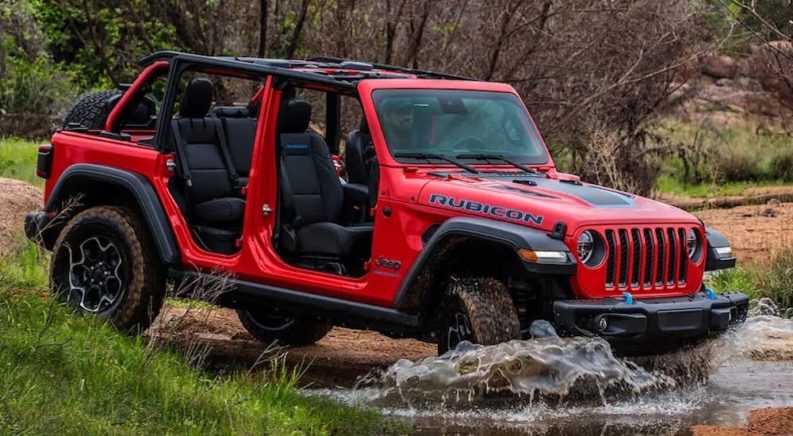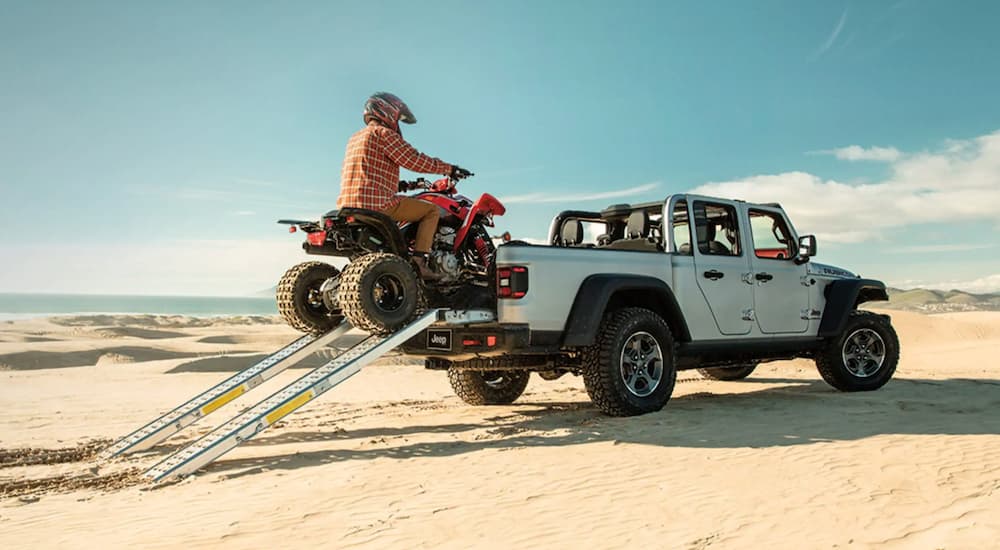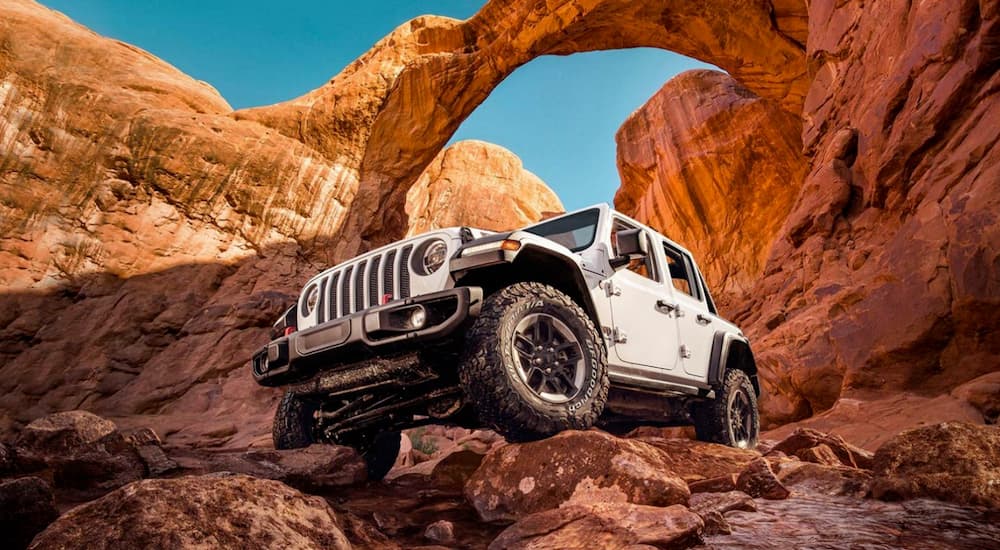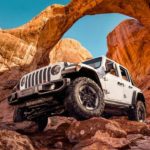The Jeep Wrangler has long been recognized as one of the most dominant names in the world of four-wheel drive SUVs, with an impressive lineage that traces its roots back to the battlefields of World War II. Based on the CJ (“Civilian Jeep”) models that made Jeep a household name over the decades, the Wrangler shares the same solid axles, open tops, body-on-frame design, and many other traits with its wartime forerunner. These same attributes make the Wrangler an exceptional off-roader––a reputation that was further solidified in 2003 with the debut of the Wrangler Rubicon, a new trim offering that added some serious off-road gear to the mix. These upgrades included locking front and rear differentials, four-wheel disc brakes, a 4:1 low-range gear ratio, and massive 31-inch all-terrain tires, making the Rubicon the new gold standard for off-road SUVs.
Seeing a Jeep Rubicon for sale immediately conjures an image of sun-soaked days spent tearing through the dirt, mud, and rock. While the model’s dominance has never been in question, a new Jeep offering is making a compelling case for itself with a long list of heavy-duty components that could give the Wrangler Rubicon a run for its money. So how does the Jeep Gladiator stack up against the Wrangler Rubicon?
An Off-Road Challenger
First, let’s start with the most obvious difference between the two models: one is an SUV, while the other is Jeep’s first pickup truck offering since 1992, when the brand discontinued the Comanche pickup. The return of a truck-based offering is big news for Jeep, which has long maintained its dominance in the off-road arena thanks to a lineup of appallingly good SUV options. So why get back into the truck game now? In one word: competition. More and more automakers have been rolling out off-road-ready pickups and even full-blown supertrucks in recent years, with models like the F-150 Raptor and Ram TRX making waves upon their debuts and stoking the public’s imagination when it comes to off-road dreams.
When it comes to off-road gear, the Wrangler Rubicon and Gladiator are pretty evenly matched, depending on which trim you choose. While the base model Gladiator can’t hope to keep up with the Wrangler Rubicon’s off-road ability, the pickup is also available with the same Rubicon package that’s made the Wrangler such a stand-out in its class. When equipped with the Rubicon trim, both models come with heavy-duty Dana 44 front and rear axles. Built to withstand the rigors of off-road life, these axles are built of sterner stuff than your average passenger vehicle, giving drivers the confidence to tackle whatever the trail can throw at them.
Both the Wrangler Rubicon and Gladiator Rubicon also feature a disconnecting front sway bar, which allows drivers to increase their front wheel articulation at the push of a button. This can be vital when it comes to surmounting tough off-road obstacles, giving the Jeeps the added flexibility they need to power through whatever terrain they might find. Tru-Lok electronic-locking front and rear differentials come in handy for low-speed rock crawling, while Jeep’s Rock-Trac part-time four-wheel drive system ups the ante by giving drivers a 4:1 low gear ratio that ensures maximum torque by letting drivers achieve a 73:1:1 crawl ratio even at very low speeds.
A Shared History
The gap in off-road equipment aside, the two models aren’t as different as one might initially think. The Gladiator, which debuted in 2019, is actually based on the same platform as the Wrangler JL. The midsize pickup does make a few important tweaks that set it apart from the Wrangler model, with the most obvious being the inclusion of a five-foot cargo bed behind the cabin. Other changes include upsized grille slots which, in a nod to the Gladiator’s towing and hauling applications, allow for increased engine airflow and cooling. Unlike the Wrangler, where the spare tire is mounted to the rear tailgate, the Gladiator’s full-size spare tire is stored under the cargo bed.
The Gladiator does retain one important design feature that’s helped to set Jeep models apart over the years: removable panels. Drivers can fully remove the Gladiator’s front and rear doors and lower the windshield, allowing them to customize the truck for whatever sort of adventures the day might call for. The pickup also features four different styles of removable tops, including vinyl and fabric soft tops, as well as three-piece hard tops in either black or a color-keyed option that accents the Gladiator’s paint job. This sets the Gladiator apart in the competitive midsize truck segment, where it’s the only model on offer to include a convertible folding soft top.
The Wrangler Rubicon has remained largely unchanged since the debut of the fourth-generation JL model in 2019, and with good reason. Jeep has hit on a winning formula with the Wrangler’s boxy, utilitarian design, which has become as much of a trademark as the Jeep name itself. The SUV shares the Gladiator’s removable top, panels, and foldable windshield but is slightly more customizable than the pickup as far as the doors are concerned. Most Wrangler models––with the exception of some special edition trims––are available in both two and four-door configurations, while the Gladiator is exclusively sold as a four-door model. While this makes it a versatile family vehicle, it does limit its off-road capability when compared to the Wrangler Rubicon, but we’ll get into that in the next section.
Size Matters
When it comes to off-roading prowess, size makes a big difference. This is one area where the two Jeep models differ, with the larger Gladiator actually losing points to the Wrangler Rubicon in terms of off-road capability. That’s not to say the Gladiator doesn’t excel off-road, but when compared to the more nimble Wrangler Rubicon, its size is something of a drawback. The Wrangler Rubicon has a 118.4-inch wheelbase in its four-door Unlimited guise and just 96.8 inches when opting for the two-door version, which is considerably shorter than the Gladiator’s 137.3-inch design.
Those extra 18.9 inches might not seem like much of a difference, and while the added length might hardly be notable when navigating city streets or the highway, the difference can be night-and-day once you start hitting the trails. A vehicle with a longer wheelbase is more prone to bottoming out when tackling steep off-road terrain and obstacles, giving the Wrangler Rubicon a decided edge. That said, bottoming out isn’t the end of the world, as both the Gladiator and Rubicon are equipped with skid plates designed to absorb the impact from rocks, logs, and other off-road obstacles conspiring to wreak havoc on the vehicle’s underbody.
Bottoming out can be somewhat compensated for with the use of larger, all-terrain tires or a lifted suspension, but no amount of rubber or aftermarket work is going to allow the Gladiator to match the Wrangler Rubicon’s inherent design advantages.
The differences are even more pronounced when looking at the models’ overall length, with the Wrangler Rubicon measuring in three-feet shorter than the Jeep pickup. Unlike a longer wheelbase, which can present problems for the underbody components located between the front and rear wheels, a larger overall length opens the front and rear sections of the underbody up to abuse from off-road hazards. Again, a few bumps and scratches aren’t the end of the world on these rugged Jeep models, but if you’re looking to combat the anxiety that comes with hearing a resonant “clunk” echo through the vehicle, the Wrangler Rubicon provides some valuable peace of mind. While both models can be customized to improve off-road clearance, drivers will have to sink a lot of cash into the Gladiator to bring it up to the Wrangler’s level.
SUV or Truck: Which Is an Off-Roader’s Best Choice?
While Jeep has done an admirable job of injecting the latest in off-road 4×4 tech into its new pickup model, the Wrangler Rubicon is still the king of the hill when it comes to getting down and dirty. The iconic Wrangler trim takes everything there is to love about the Jeep brand and kicks it up a notch, giving drivers all the heavy-duty components they need to excel in their off-road antics. From mudding to overlanding and rock-crawling, few 4x4s are as well-equipped right out of the box as the Wrangler Rubicon. The Gladiator does present an alluring new choice for drivers who are looking to mix the utility of a pickup with the fun of a true off-road 4×4, but its larger size does hold it back a bit when it comes to matching some of the Wrangler Rubicon’s off-road achievements. That shouldn’t keep you from exploring the pickup, but we know which model we’ll be backing down the driveway the next time the trail calls.






